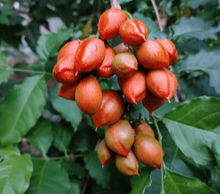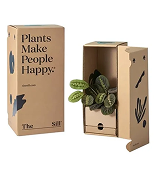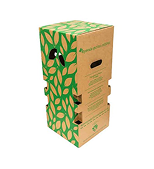- Home
- All Fruit Plants
- Peanut Butter- Fruit Plants
Peanut Butter- Fruit Plants





Peanut Butter- Fruit Plants




Damaged or lifeless? We’ll replace it for free. Learn more

Double layered custom boxes to protect plants during shipping.

Air vents for proper air-flow

To preserve plant freshness during transit

Details steps of how to grow and maintain your plant
Rich in essential nutrients like vitamins A and C, potassium, calcium, and dietary fiber, Peanut Butter Fruit supports immune function, vision health, and overall well-being. Loaded with antioxidants such as flavonoids and polyphenols, it combats oxidative stress, promotes digestive health, and contributes to heart health. Low in calories and fat, Peanut Butter Fruit is an ideal snack option for weight management and provides a quick energy boost for active lifestyles.
Growing Tips:
- Opt for well-drained, fertile soil with a pH of 6.0 to 7.0 in sunny locations.
- Maintain soil moisture, especially during the growing season, without waterlogging.
- Prune annually to remove dead or diseased branches and maintain shape.
- Apply organic fertilizer rich in nitrogen, phosphorus, and potassium during the growing season.
- Protect young plants from frost using blankets or frost protection methods.
Inside the Box:
Peanut Butter Fruit Plant: Approx. 1-2 Feet Height
Growing Pot (Brown color): 8 Inch
Fruition Time: Our Peanut Butter plants come with fruits and flowering already established.
Initial Care for 10-15 Days Just After Receiving Your Plant:
- Unpack carefully to avoid damage.
- Firmly press soil in the pot for stability.
- Maintain consistent soil moisture, allowing the top inch to dry between watering.
- Place in a sunny spot for 6-8 hours daily during the initial 10-15 days, avoiding immediate transplanting.
- After one month, consider transplantation into a larger pot or directly into the ground.
- Prune any damaged branches to stimulate new growth and maintain plant health.
Selected plant of 8-10 inches
Planted into a 5-inch pot
With healthy, moisture-retaining soil
A care instruction sheet for maintenance guide

Get in touch for best pricing on bulk orders and landscaping projects.
 WhatsApp us
WhatsApp us

Call on 9177805454 (Mon-Sat, 9 AM-6 PM) or WhatsApp us – we’re here to help.
About Exotic Flora
At Exotic Flora, we’re passionate about bridging the gap in bringing plants to everyone. With over 500+ varieties across 7 plant categories, from exotic finds to everyday greens, we bring the entire range to you.
Our plants, sourced from all parts of India are nurtured at Kadiyam, in our 25 acres in-house nursery by a team of expert horticulturists. Once they are ready we ship all our plant varieties across India.
Our services go beyond safe delivery of plants. A dedicated support team is there to help you with any maintenance queries you may have.
At Exotic Flora we always believe in going that extra mile, because everyone should have the plants they love.
Every, fruit plants vary in their fruiting time, depends on location, climate & age of the plants. Generally, Grafted fruit plants starts fruiting within 2 years of planting, where as non-grafted plants take more than 2 years. You can check the fruiting time of each plant in the plant description.
No, Majority of fruit plants are not delivered with fruits. But some grafted fruit plants can be delivered with fruits and flowers mostly Citrus, Guava, Star fruit, Fig, Ber etc. But it is recommended to remove the flowers during early days, so that plants can get more branches and physical strength.
Grafting is a technique where two plants part are combined together so that they can grow together. Most commonly seen in Mango. Air Layering is also a vegetative propagation technique where a plant is produced while it is still attached to its parent's plants. Commonly seen in Guava. Stem cutting is a vegetative propagation technique, where soft, semi-hard, or hardwood stem is cut with 2-3 nodes and used for the multiplication of plants. Commonly seen in flowering & ornamental plants.
Yes, the grafted fruit trees produce fruit earlier, than the non-grafted fruit plants.
These are some of the rare and new fruit plants and it's varities, which are not avialable everywhere in our country.
Remove the plant from its pot. Make sure to not disturb the root ball. Place the plant in a prepared pit(1x1ft) or slightly bigger pot than the current pot. Firm the soil around the plant with your hands. Water well till it drains out from the drainage hole.
In order to maintain the good shape of the plants, proper care should be taken from the beginning like the pruning of unwanted and diseased parts of plants, stalking to young plants, regular maintenance of plants.
In General, a grafted/air layered/hybrid fruit takes 2 years for fruiting, whereas seeded grown plants take 4-5 years of time for fruiting. But it may vary depending on the plant types.
In general if your soil weell drained, fertile and organic in nature, it will produce good quality fruit. Sandy-loamy is the most preferable soil used for fruit plants.
Size and taste of each fruit plants varies depending on the varieties. You can find more details about each fruit plants in terms of size and taste in the description of individual plants.
Initial first 2 years are very important to feed the plants with organic manure and fertilizers regularly. It is recommended to add organic manure or compost to each plant in every 3 months of time intervals. Do not go for Chemical fertilizers it will weaken the plants in future.
Plastic pots with drainage holes preferably work best as they are lighter to move around. Any other container which is light in weight with a drainage hole can also work to grow fruit plants.